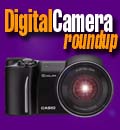 When I made David MacNeill editor-in-chief of Digital Camera Magazine I found myself in a bit of a predicament. Not because I mourned having relinquished the EIC position to Dave who is clearly the very best person for that job, but because during the six years-plus that I have been editor-in-chief of our sister publication Pen Computing Magazine, I have grown quite fond of the EIC's prerogative to provide commentary and opinion in the main editorial at the beginning of the magazine. The EIC's editorial is unique because unlike reviews or specific columns it provides complete freedom to talk about whatever seems most appropriate at the time. So what did I do? I hogged the next most prominent spot in the mag, the last page. I've always liked that spot because one of my favorite writers, Automobile deputy editor Jean Jennings uses it to disperse her always insightful and humorous pearls of wisdom. So that's why I am here in this spot.
When I made David MacNeill editor-in-chief of Digital Camera Magazine I found myself in a bit of a predicament. Not because I mourned having relinquished the EIC position to Dave who is clearly the very best person for that job, but because during the six years-plus that I have been editor-in-chief of our sister publication Pen Computing Magazine, I have grown quite fond of the EIC's prerogative to provide commentary and opinion in the main editorial at the beginning of the magazine. The EIC's editorial is unique because unlike reviews or specific columns it provides complete freedom to talk about whatever seems most appropriate at the time. So what did I do? I hogged the next most prominent spot in the mag, the last page. I've always liked that spot because one of my favorite writers, Automobile deputy editor Jean Jennings uses it to disperse her always insightful and humorous pearls of wisdom. So that's why I am here in this spot.
However, I felt that I did have to observe the rules to some extent and couldn't just provide free-form commentary on whatever popped into my mind as I would in an EIC column. Initially I didn't know where the View Finder column would go, but I quickly found it to be a good spot to write about the special relationship I have with digital cameras. That relationship can be summarized as follows: a) I love digital cameras and think they are one of the greatest advances to come down the pike since the original IBM PC; b) I am not a professional photographer, just a regular guy who wants to use digital cameras to take pictures; and c) I feel a duty to point out a number of areas where digital photography is still lacking.
I seem to have struck a nerve with the column as evidenced by the good number of email responses I get after every issue. Some of those emails accused me of being overly negative and suggested that I should perhaps return to the "traditional photography whence I came from." (I was never there.) The great majority of responses, however, seem to indicate that the problems bedeviling digital photography I talk about in my columns are real and that digital imaging vendors better listen up if the phenomenal growth rate of digital cameras is to continue.
And let's be clear here: the growth rate has been phenomenal, far exceeding even the most optimistic projections. According to the NPD Group, in October of 1999 nearly 19% of all cameras sold were digital as compared to just seven percent in October of 1998, and sales of digital cameras increased 53% in the first ten months of 1999 to US$677 million in the US market.
The report didn't include statistics on return rate which, by most accounts, are very high. Why is that? For exactly the reasons I have been harping about in this column: lousy battery life, difficulty connecting to a PC, the long wait until the camera is ready again to take the next picture, and the complexity of getting hard copy. Other items on my gripe list are the unacceptable fragility of some digicams, LCD displays that are unreadable outdoors, cumbersome user interfaces, lousy documentation, and an ill-fated marketing approach that doesn't differentiate between film and digital cameras.
That's quite a damning list and sometimes I feel a bit like the great John Dvorak must have felt when he wrote his devil's advocate columns in MacUser way back when. Dvorak was a big fan of the Mac then, but he felt a need to point out all the screwy things that were wrong with Apple and its products. Well, I am a great fan of digital cameras, but I feel a need to continue to point out what's wrong with them just because I want them to become as great as they can be.
So let me summarize where I think we stand with this technology. Just over two years ago I bought an Olympus D300L and found it good enough not only for work in commercial magazines (a large percentage of the images in our sister publication Pen Computing Magazine have been from digicams for the past two years). I was so excited that I suggested to my business partner that we start Digital Camera Magazine, which premiered early 1998. Later in 1998 I nervously decided to entrust all those once-in-a-lifetime pictures on a fairytale Japan to my Nikon Coolpix 900. I expected the worst, but the Coolpix never let me down, filling my CompactFlash cards with over 130 pictures on a single set of Lithium Ion AA batteries.
I was high on digital photography for several months, but then clouds reappeared. My expensive Coolpix 900 was obsolete within months and then literally broke in half when I accidentally dropped it from not much more than a foot. It took Nikon several weeks to fix it and ever since I get wavy color patterns on every tenth picture or so. Several reviews during 1999 showed me that while pixel resolution increased dramatically, user interfaces, manuals, and PC connectivity remained as lacking and confusing as ever. It seems that some manufacturers just don't get it and keep sticking consumers with nearly unusable products that are obsolete almost before you leave the store.
Fortunately, there is good news as well. Nikon, one of my favorite digicam vendors, has clearly been listening to criticism. The Coolpix 950 is a sensational camera and a huge improvement over my beloved Coolpix 900. Both the 950 and the 850 have virtually eliminated the endlessly frustrating wait between recording and playback mode. The higher resolution means less anxiety about putting every last precious pixel to work on the subject rather than framing. The Coolpix 800 gets amazing (by digicam standards anyway) battery life out of a set of ordinary alkalines. My Lexar CompactFlash card reader works like a charm. Just pop in a card and it appears as a disk drive on the desktop. And the totally terrific HP PhotoSmart P1100 printer is a veritable personal photo lab.
So keep at it, vendors. There's a lot of gold in them that hills and you don't want to blow it.








